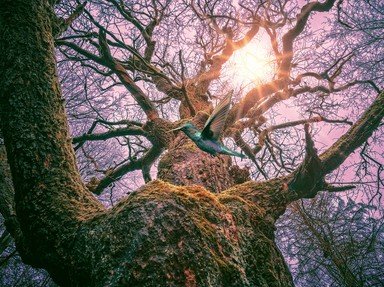Quiz Answer Key and Fun Facts
1. Ralph the Llama is able to unlock the door to the giant panda enclosure, but an instrument is needed to hold it open. Eager to return to China, the giant panda graciously offers his last stick of bamboo, which he positions perfectly. Why are giant pandas able to handle bamboo shoots with such dexterity?
2. Ralph finds a fellow mammal in this next enclosure, a tree pangolin. Though concerned about escaping with this animal and her two month old son, Ralph is assured by the pangolin that they'll be just fine. As the mother tree pangolin scampers away to freedom, what will the baby do?
3. Ralph has his work cut out with this next animal, the giraffe. Though the giraffe is far from inconspicuous, it is able to reach the external switch to the park gates, which it unlocks using its ossicone. What is an ossicone?
4. As Ralph continues on his one llama mission to free the animals of Funtrivia Zoo, he now enters the Reptile Room. He cannot make heads or tails of the pair of lizards in front of him, as they, curiously, are monogamous and will give birth to live young. However, Ralph soon shakes off the confusion and escorts them out. What type of lizard is being described here?
5. Though he first thought he was observing a snake, Ralph the Llama soon realises that this next creature is actually a limbless amphibian, a caecilian. This caecilian is a mother and appears prepared for the long journey home with her young, even having what she calls a "packed lunch." Which of these strange methods of feeding is true about some caecilians?
6. Ralph the Llama can sense that time is running out and so gives a quietly urgent call up to the trees in this next enclosure. The animal which answers, luckily, is one of the swiftest arboreal movers and can climb down a tree faster than almost any other, thanks to flexible ankles which allow its feet to point backwards. What animal is this?
7. Though many of the animal encounters Ralph the Llama has had so far were amicable, some are not so happy about being "rescued". With a frenzied cry of "draw!" from this next animal, Ralph is covered in a glue-like substance which it squirted from a pair of modified legs. Which animal has Ralph just encountered?
8. As Ralph the Llama enters the bird sanctuary at Funtrivia Zoo, he releases a North American bird which earlier caught his eye, with its stunning flashes of yellow, red and blue feathers. Which type of bird is being described here?
9. Another of Ralph's escapees is the slow loris which, as well as holding up the group, is carrying a baby. Why is this baby likely to get on the nerves of the animals surrounding it?
10. The escape route of Ralph and his many animal escapees is blocked by a series of motion detecting lasers, which use ultraviolet (UV) light, invisible to Ralph. Three animals, however, step forward and offer their services to the group. They are named Tom, Dick and Harry, and each is able to detect UV light. Which of these animals cannot be Tom, Dick or Harry?
Source: Author
doublemm
This quiz was reviewed by FunTrivia editor
crisw before going online.
Any errors found in FunTrivia content are routinely corrected through our feedback system.

